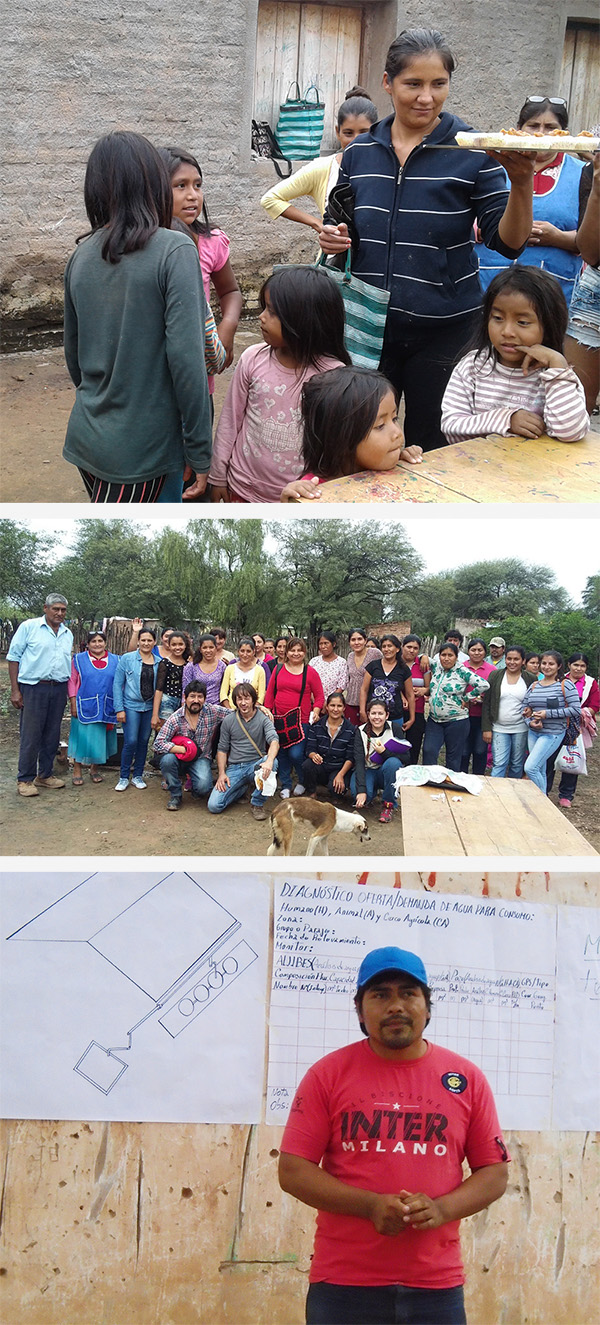Stories of Change

Photos: FUNDAPAZ
CWS and partners have helped build 25 rooftop rainwater catchment systems in local schools, increasing the rainwater harvest and storage capacity by 160,000 gallons.
Source: CWS Annual Report 2017
“We do not want to die carrying water”
With their low-key but hardworking attitudes, listening skills, respect for the wisdom and experience of the elderly and a smile, Rebeca Soraire and Nestor Montes are transforming rural South America and inspiring many others to follow. Both under 30, they play key roles in a major collaborative effort supported in part by faith-based organizations Food Resources Bank and Church World Service aimed at promoting rain water harvesting from rooftop catchments in communities on the Bolivia-Argentina border. This is possibly the hottest place in South America, where more than 2,000 indigenous and campesino (impoverished farmer) families living in remote locations face chronic water deficits.
Between 100 and 80 years ago, campesino settlers called criollos moved to the area, creating tension and conflicts – sometimes violent – over land use between these cattle ranchers and the indigenous, semi-nomadic hunting and gathering Wichi people. Rebeca Soraire is the granddaughter of one of those criollo settlers, who today are poor as their indigenous neighbors.
In addition to being active in the local Catholic parish and in a computer literacy class opened to criollo and Wichi students, Rebeca serves on the board of the regional criollo association of Los Blancos, Argentina. She is also one of the few women on a local inter-ethnic team that surveys families, calculates their water deficit and helps to create maps using modern technology like GPS equipment and Geographic Information Systems. Those maps – that today include information of more than 2,000 families – are critical tools to support water-related advocacy. “We do not want to die carrying water,” says a very determined Rebeca.
“At first, I didn´t really like to use a GPS, cameras and household questionnaire surveys. This changed when we realized that they were really going to help us. Community mapping helped us to show the rest of the community and authorities not only the extent of how serious the water problem is in the area but also who are the families that need to be prioritized. For instance, out of 130 families in one community, 120 had land titling problems and all of them lack access to safe water.” In this region, drought commonly lasts six months, and the water deficit is so serious that harvested rainwater is used exclusively for human consumption.
Meanwhile, skilled construction worker Nestor builds rooftop rainwater catchment systems. He and other members of the community learned to build the type of cement cistern that CWS and FRB’s local NGO partner Fundapaz brought from Brazil´s Northeast region. In addition to building cisterns in the area of Los Blancos, where he lives, Nestor now travels to train others in places as distant as Santiago del Estero or even across the border in Bolivia. It takes Nestor and his teammate between five and seven days to build a 4,226 gallon cistern, which includes time for him to train a group of local interested people in how to build cisterns themselves. “It is great feeling when you build the first rainwater harvesting system in a community, but many more are needed. Water is our number one problem,” he says. The last two cisterns Nestor built in two criollo communities benefited 34 families (some 190 people).
Nestor is also a rising community leader of the Wichi people, who are now transitioning to permanent settlements as a result of internal migration and the resulting land-grabbing and land disputes in the region. In his role as regional representative of the Wichi people, Nestor frequently meets with federal, provincial and municipal public officials and government agencies to discuss community development initiatives in the areas of water, education and health. His participation is also needed when is necessary to solve or prevent community conflicts including inter-ethnic conflicts between indigenous and non-indigenous members of the community. In Nestor’s words, “There are conflicts that separate the Wichi from the criollos but we are not enemies. And when it comes to water, for instance, there is no difference between us.” Nestor builds, teaches, advocates and is also a peacemaker.
Recently, Rebeca and Nestor traveled to a regional conference organized by Fundapaz and IFAD, the United Nations agency for agricultural development, on community mapping as a tool to promote access to water, land and conflict resolution. After their presentations, a journalist from a national newspaper asked Rebeca how she manages to be so peaceful and the community manages to remain united when the water situation is so desperate, and the needs and injustice are so serious. She paused for a few seconds and answered: “It is not easy, but we will never use violence because we are poor and as the weakest members of community we are sure we will get the worst part.”
Nestor, Rebeca and the community organizations they represent are vital players in the local water working group that Fundapaz helped to create. Other working group members include the provincial government of Salta and local NGOs and community-based groups. CWS is one of the two international observers invited to accompany the working group. If successful, the landscape of this semi-arid part of South America known as the Gran Chaco will change forever with hundreds if not thousands of rooftop rainwater harvesting systems become a familiar feature in towns and rural houses.
And with people like Rebeca and Nestor hard at work, change has already begun.
